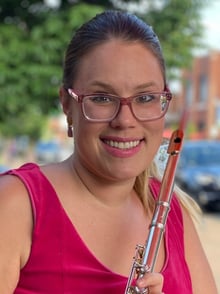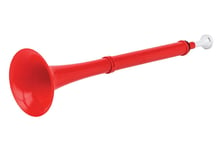Search for topics or resources
Enter your search below and hit enter or click the search icon.

Dorothy Pino is a veteran music teacher, teaching for over a decade in California, Denver, St. Louis, and abroad. Dorothy was a teacher for over seven years within Denver Public Schools where she introduced the pBuzz early learning instrument at a K5 elementary school with 560 pupils whom she saw around 5 times a month each. More recently, she has provided clinics for music teachers for both general music and modern band applications.
We recently asked Dorothy to provide some observations on the impact of pBuzz on student music education:
 What did you expect back when you first started using pBuzz in your music classroom?
What did you expect back when you first started using pBuzz in your music classroom?
When I first started using pBuzz in my classroom, I saw it as a great way to introduce the brass embouchure, note reading, and improvisation to my students. The reaction to the instruments was positive and engaging students with music in a non-traditional way was really successful.
What did you find as you moved forward with pBuzz in your curriculum?
While the pBuzz fulfilled all my expectations, I realized many additional skills were being learned.
 Looking back, what advice do you have for other educators who might be thinking about introducing pBuzz into their classrooms?
Looking back, what advice do you have for other educators who might be thinking about introducing pBuzz into their classrooms?
If I were to start over in the introduction process, I would have students practice singing intervals and echoing them on the pBuzz afterwards, so that this learning was more overtly taught from the beginning.
I would also discuss how helpful the pBuzz is in learning how to breathe for all band instruments, not just brass. While the recorder may help with the fingerings of the woodwind instruments, it fails to show students the amount of air pressure all wind instruments need to produce sound. By developing better breath support and pitch distinction, students will develop one of the most important lifelong music skills - a singing voice! No matter where students take their music skills in life, a singing voice is something they will always be able to take with them.
Would you like to learn more about incorporating pBuzz into your classroom activities? We have many resources that are available to help.
Rich grew up on Chicago’s south side and attended Marist High School, where he was an active member and drum major of the school’s marching band. He attended Elmhurst College (University), receiving a degree in marketing and music-business. His early career included time at the Chicago Symphony and Ravinia Festival organizations, as well as classes at the Chicago-Kent College of Law. Rich’s career has been dedicated to music education. He has worked closely with educators, professionals, retail businesses and corporations. He has established key education partnerships and has served on the board of directors for several non-profit education organizations. He has provided executive planning and marketing acumen for 21st century companies through Strategic Marketing Management, LLC since 2011. Prior to opening his own firm, he served in key management roles at KHS America, Inc., the Conn-Selmer division of Steinway & Sons, Inc., and United Musical Instruments, all worldwide manufacturers and distributors. He served in the management of the SMART Foundation which provided programs and advocacy support for arts education. He has also authored several publications focused on the arts and education and has served on the boards of non-profit music education organizations.
Topics: